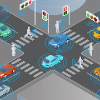This report aims to support the Tennessee Department of Transportation's decisions about vehicle and infrastructure communication technologies. The transition from Dedicated Short-Range communication (DSRC) V2X to Cellular Vehicle to Everything (C-V2X) is explored using USDOT guidance on relevant issues and presenting the results of experimentation in Tennessee and the potential pros and cons. DSRC V2X technology has been planned at traffic signal in Tennessee, e.g., 152 Roadside Units (RSUs) were planned by TDOT using DSRC V2X and Bluetooth combination units in the I-24 smart corridor. Similarly, many pilot programs and testbeds around the nation have deployed DSRC V2X technology and are now impacted by the Federal Communication Commission's (FCC) ruling on opening safety band. The implication is that DSRC V2X deployments (and future deployments) should migrate to C-V2X. Notably, dual-mode RSUs are available along with LTE C-V2X. The transition can be done by working with vendors, but surely this involves more than swapping DSRC V2X devices with LTE C-V2X devices. Complicating the migration to C-V2X is TDOT's role in traffic signal operations and maintenance, which is limited to funding and designing/construction of traffic signals, but local agencies operate and maintain signals. Hence, local agencies will work with TDOT to operate and maintain C-V2X technology. Moreover, C-V2X technologies are not widely tested-interference by unlicensed devices and channel congestion can adversely affect safety-critical applications. Given the substantial uncertainties in transitioning to these technologies, TDOT's discussion with IOOs about the operation and maintenance of C-V2X may have to wait for the resolution issues, while TDOT can invest in experimentation with dual-mode devices. Recommendations are provided about dual-mode devices, CAV data, and needed research and testing.
翻译:----
本报告旨在支持田纳西州交通部关于车辆和基础设施通讯技术的决策。使用美国交通部对相关问题的指南,探讨了从专用短程通讯(DSRC)V2X到车联网通信(C-V2X)的过渡,并呈现了田纳西州实验的结果、潜在的优缺点。田纳西州的交通信号计划使用DSRC V2X和蓝牙组合装置,例如,TDOT在I-24智能走廊上计划部署152个路边单元(RSU)。类似地,全国许多试点项目和测试平台已经部署了DSRC V2X技术,现在受到联邦通信委员会(FCC)在开放安全频段方面的影响。这意味着DSRC V2X的部署(和未来的部署)应该向C-V2X迁移。值得注意的是,双模RSU和LTE C-V2X同时可用。迁移可以通过与供应商合作来实现,但需要更多的工作,而不仅仅是用LTE C-V2X设备替换DSRC V2X设备。使C-V2X迁移复杂化的是TDOT在交通信号运营和维护方面的角色,其仅限于资金和交通信号的设计/建设,但是地方机构负责运营和维护信号。因此,地方机构将与TDOT合作运营和维护C-V2X技术。此外,C-V2X技术尚未广泛测试,因为未经授权的设备干扰和频道拥塞可能会对安全关键应用产生不利影响。考虑到这些技术迁移中的重大不确定性,TDOT关于与地方机构的C-V2X运营和维护的讨论可能需要等待问题的解决,而TDOT可以投资于双模式设备的实验。提供有关双模式设备、CAV数据和所需的研究和测试的建议。



